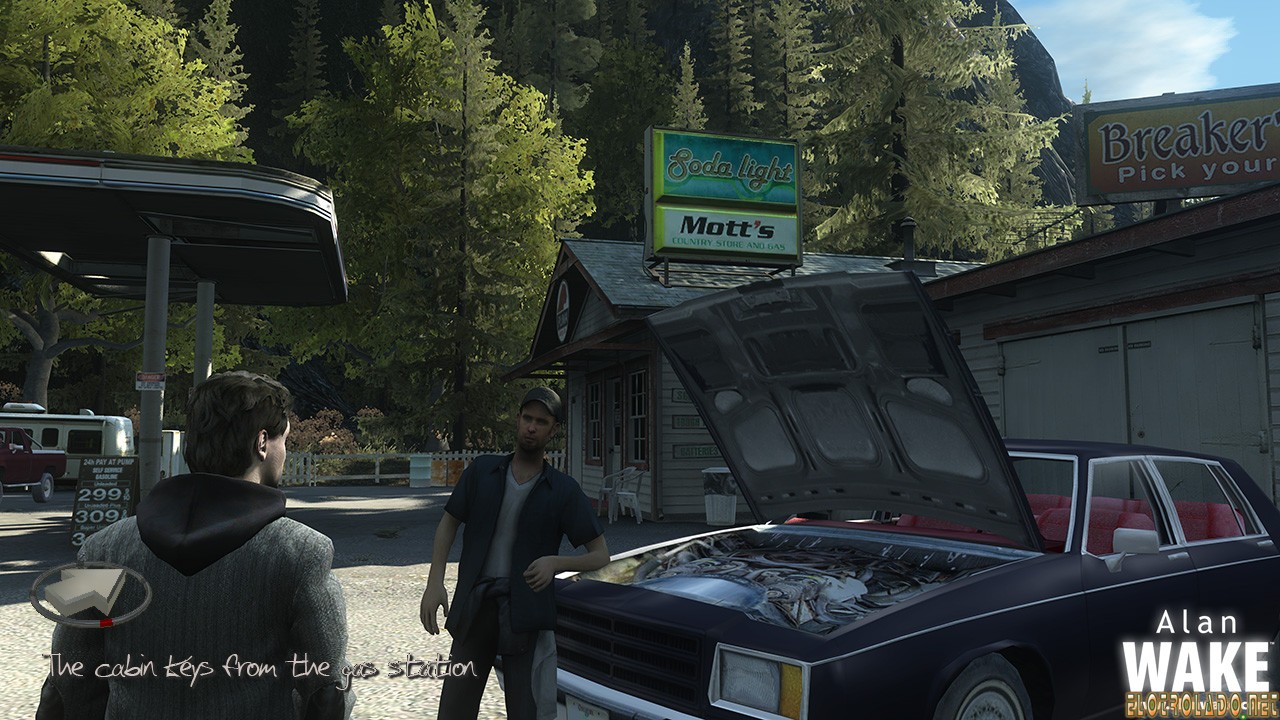September 28, 2006 - Like any smart developer who's working on a next-generation game, Remedy went dark for a long time before re-surfacing with something spectacular to show. It announced its game, Alan Wake, crept into its studio (read: cave) and went to work (i.e. slaved away until its game looked decent enough to show to the public). The result, we witnessed at X06 in Barcelona, Spain, today, is one of the freakiest, scariest and most impressive games of the year.
When Alan Wake was first announced, the video and the description seemed all too vague and a little heady for my tastes. What do I want to know about a depressed writer who is having troubles with his dreams? My first, uninformed opinion was "Booorrr-ring." Funny how a good demo can change your mind.
Alan Wake is a single-player, offline, action-adventure game; or, as Remedy likes to call it, a "cinematic action thriller." Notice how the words "survival horror" weren't part of the description? Like the folks behind Alone in the Dark or even Irrational Games and its "first-person shooter," BioShock, part of this new generation of games is about changing old perceptions, creating new experiences and innovating new gameplay. If the game of Alan Wake plays remotely like the demo we witnessed today, you're going to want it. It's gorgeous, smartly thought out, and scary.
If you haven't heard the backstory yet, let me inform you. Alan Wake is a writer who is writing a novel. It's going OK, but as soon as he connects with his new girlfriend Alice, the writing really takes off. He writes a psychological thriller that almost writes itself. Interestingly, the narrative is somewhat autobiographical and a lot the material comes straight from Wake's dreams. Once complete, the book hits the top of the sales charts, becomes a best seller, and everyone lives happily ever after.
Then Alice disappears.
Wake can't find her. There is no trace of her disappearance and he head dives into deep depression. He is unable to write or do anything, so he moves to Washington State and begins seeing her in visions and in his dreams. He sinks further into depression and cannot sleep, and soon the line between reality and subconscious, life and dreams, blurs.
The intro footage of Alan Wake is a fully-fledged movie montage, complete with orchestrated strings and dramatic themes. It sets a tone and the game picks up the dark and dramatic themes from there. Remedy's Lead Writer Sam Lake and the lead developer take turns explaining the ideas behind Alan Wake, how they created the technology that's given them a massive re-creation the Pacific Northwest in a 10 x 10 kilometer space, and how they plan on engaging players in their psychological thriller. The game sports high dynamic range lighting which does an excellent job of reflecting light off cars, lakes, and shiny hard-packed snow. They use a dev cam to zip across the landscape to show the game's incredible detail, zooming to a mountain top, where Alan Wake is posing, and then without a hitch, the camera zips across the landscape to another area.
They show how the weather conditions are entirely fluid and seamless, changing from day to night, flowing in thick clouds, creating fog, and altering the wind patterns. They show the best part of the demo (or at least the second part), a twister. The twister isn't pre-canned. They created it and they steer it across a small parking lot, smashing up houses picking up debris and hurling it across the screen. Alan Wake runs across the street and just when you think the twister is over and the debris has finished falling, a car crashes down from the sky, missing you by inches. That, Remedy admits, was pre-planned. But it can happen in the game. Alan Wake enters a warehouse or a garage as Remedy switches the day into night. Wake carries a flashlight to see through the pitch black. The dynamic lighting is excellent, fluidly moving across objects, surfaces, and windows with realism.
After teasing us with their technical abilities, a weakness that both developers and gamers have in common, Remedy starts taking up the story again. The story will be told in episodes like a TV series, each part of the story having a little beginning, middle and end. Wake decides to head to his cabin on a nearby hill and the Max Payne-like narration kicks in, describing his feelings. His book is coming along OK, and he's reached this part in the story where the lead character picks up a hitchhiker who kills him. Then, in the game, Wake picks up a hitchhiker. Wake narrates that he's not sure why he instantly starts spouting the details of his book to this seemingly quiet hitchhiking man. He tells the hitchhiker that in his dreams the hitchhiker...just then he's interrupted by the passenger, who perfectly finishes Wake's thoughts. Wake is confused, but before the thought can develop, he pulls the car over. An accident has happened, blood is splattered everywhere, and a female body lies still on the pavement appearing dead. Wake gets out and inspects it. But the accident happened near a blind turn and a semi truck flies around the corner, sees Wake in the middle of the street, veers left and smashes into Wake's car. Unfortunately, the hitchhiker is still in it. Wake then passes out.
Sometime later he wakes up with a flashlight and an item in his hand, the female body is gone, and so is the hitchhiker's body. It's getting toward dusk. Frightened, Wake runs down the street to a rope bridge, crosses it, and then hears his name being called. The camera zooms across the street to the scene of the accident, and the voice of the dead hitchhiker creepily calls out Wake's name. The camera appears to take on the perspective of the hitchhiker, which you can't see, and it moves toward Wake. The camera switches back to Wake, and you can see the bridge bobbing up and down, as if someone was walking on it. Just as it seemed like the ghost, or whatever it was, reached the end of the bridge, the strangest thing happened. The demo froze. We didn't know what was going, but the demo really did freeze, we were assured, and that this wasn't a stunt to scare and confuse us even further. (Or...was it?) Remedy thanked us, and the session ended.
I'm not fully convinced that words describe the beauty, atmosphere, and stunningly scary tone that Remedy was able to achieve in that short demo, but suffice to say, it did. Alan Wake is now firmly on my must-have list and we'll be keeping a close tab on it until its release next year.


 ¡Bienvenido a mundodvd! Regístrate ahora y accede a todos los contenidos de la web. El registro es totalmente gratuito y obtendrás muchas ventajas.
¡Bienvenido a mundodvd! Regístrate ahora y accede a todos los contenidos de la web. El registro es totalmente gratuito y obtendrás muchas ventajas.


 LinkBack URL
LinkBack URL About LinkBacks
About LinkBacks





 [/center:bbff6bc6b1]
[/center:bbff6bc6b1]










